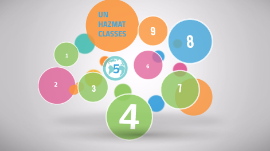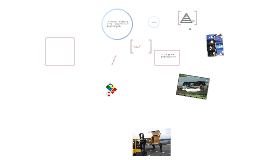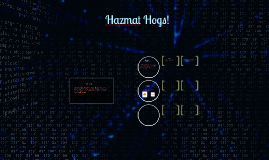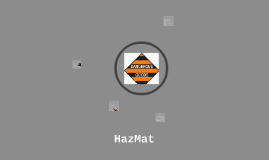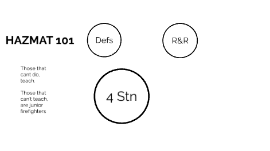HAZMAT
Transcript: HAZMAT 101 Defs What is a Hazardous Material? Any substance or material that poses an unreasonable risk to health and safety of persons and/or the environment if it is not properly controlled during handling, storage, manufacture, processing, packaging, use disposal or transport Discarded materials with no monetary value that can have the same hazardous properties it had before being used Hazardous Waste Subtopic The temperature when a liquid changes to a gas at a given temperature. Flammable materials with low boiling points generally present special fire hazards Water = 100 C Propane = -42.04 Boiling Point Subtopic Minimum temp. when a liquid or volatile solid gives off sufficient vapours to form an ignitable mixture with air near its surface. The substances will flash, but will not continue to burn Flammable gases have no flash point because they are already in a gaseous state Flashpoint Subtopic The temp. when enough vapours are given off to support continuous burning. The fire point temp. is usually only slightly higher than the flash point The liquids themselves do not burn, but the vapours the produce do. Fire Point Subtopic The minimum temp. required to to initiate or cause self-sustained combustion, independant of the heating or heated element Ignition Temperature Subtopic Range between the upper and lower flammable limit when a substance can be ignited. Range from 0-100% Most flammable liquids 2-12% Ammonia 16-25% Alcohol 1-36% Ether 2-48% Aldehyde 3-55% Acetylene 2-82% Remember.... our LEL sensor is a % of the % Flammable Range (Explosive Range) Subtopic The weight of a given volume of pure vapour or gas compared to the weight of an equal volume of dry air at the same temp. and pressure. <1=lighter than air (Acetylene, Methane, Hydrogen) >1=heavier than air (Propane, Hydrogen Sulphide, Butane, Chlorine) Vapour Density Subtopic The pressure produced or exerted by the vapours released by a liquid. Can be viewed as the measure of the tendancy of a substance to evaporate Vapour Pressure Subtopic |The weight of a substance compared to the weight of an equal volume of water. For example, if a given volume of a substance is 8 pounds, and that same volume of water is 10 pounds, its specific gravity is 0.8. Materials >1 will sink in water Materials <1 will stay on the surface Specific Gravity Subtopic Expressing the percentage of a material (by weight) that will dissolve in water at ambient temp. When a non-water-soluble liquid (hydrocarbon) combines with water, the remain apart. When a water-soluble liquid such as a polar solvent (alcohol, methanol) combines with water they both mix easily This is important information to gather for firefighting operations as well as cleanup. Water Solubility Subtopic Gaseous, liquid or solid materials that can burn, irritate or destroy human skin tissue ans severely corrode steel. These are categorized as acids (<7 on PH) or bases (>7 on PH) Corrosivity Subtopic R&R Roles and Responsibilities Awareness level roles and responsibilites are to identify what the substance or container may be and to only direct victims or potential victims to safety or to a decon area. They are not to enter the hot zone nor try to mitigate the hazard. Awareness Level Like awareness level responders, operational responders can instruct individuals on where to go and what to do as well as classify a substance or its container. They may also assist with searches in the warm zone, and even the hot zone if rapid removal is required. They may also perform defensive strategies, assist with decon and perform reccy with technician level, on site workers and again victims. Operations Level Technician level responders are better than 12 station, are capable of organizing and running command for the hazmat team and can control and mitigate all hazardous spills and leaks. They are trained in entry, suit selection, performing and organizing a well established decon and are able to identify hazardous materials. We handle all offensive tactics. Technician Level 4 Station response to Lebanese Fusion - Pepper spray incident - Peter Lougheed Hospital -Chemical Labs in the NW Corner of our district - Parmalat (Centre and 19th) -Nose creek running along deerfoot (potential waterway issues) - Railway next to - EFW and Canada Diagnostics - Many autobody/mechanics shops -Cathouse Considerations 4 Stn http://www.calgary.ca/Transportation/Roads/Documents/Truck-and-dangerous-goods/calgary-truck-routes-map.pdf






